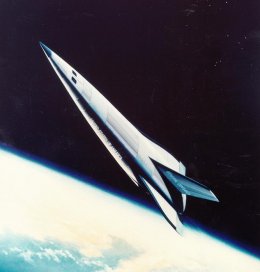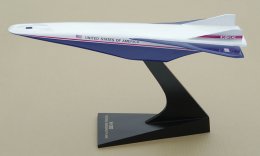Air Raid
2006-02-06 04:01:37 UTC
the NASP ~ National Aerospace Plane ~ X-30
which Ronald Reagan called " a new Orient Express" was announced 20
years ago this week during the State Of The Union address Feb 4, 1986.
the NASP would've been a single stage to orbit space plane capable of
taking off from conventional airport runways - accellerating to
supersonic, hypersonic and orbital speeds using a combination of at
least three propulsion systems (maybe 4 or 5 systems) that included
turbojets, ramjets, scramjets and possibly rockets. It would have to
sustain temps of over 1600 degrees over the surface of the airframe and
upto 5000 degrees on the outer control surfaces.
NASP would be a replacement & supplament for the space shuttle, spy
aircraft
(NASP was even more advanced than the fabled Aurora-based hypersonic
spyplane(s), subsonic and supersonic commercial airliners and military
bombers.
NASP of course never made it - and all other hypersonic efforts, and
SSTO and hypersonic efforts (i.e. X-33 ~ VenturStar and X-43 ~ Hyper-X
) have been lesser efforts that also failed
NASP ~ National Aerospace Plane ~ X-30 ~ 'Orient Express'
President Reagan's State of the Union 1986:
"we are going forward with research on a new Orient Express that could,
by the end of the next decade, take off from Dulles Airport, accelerate
up to 25 times the speed of sound, attaining low Earth orbit or flying
to Tokyo within two hours."
NASP ~ National Aerospace Plane ~ X-30 ~ 'Orient Express'
Loading Image...
Loading Image...
Loading Image...
Loading Image...
Loading Image...
Loading Image...
Loading Image...
Loading Image...
Loading Image...
concept video
http://redstone.ae.gatech.edu/mm/Miscellaneous/NASP_promo.mov
articles:
http://fas.org/irp/mystery/nasp.htm
http://www.astronautix.com/lvs/x30.htm
http://www.geocities.com/CapeCanaveral/Launchpad/8574/X30.html
which Ronald Reagan called " a new Orient Express" was announced 20
years ago this week during the State Of The Union address Feb 4, 1986.
the NASP would've been a single stage to orbit space plane capable of
taking off from conventional airport runways - accellerating to
supersonic, hypersonic and orbital speeds using a combination of at
least three propulsion systems (maybe 4 or 5 systems) that included
turbojets, ramjets, scramjets and possibly rockets. It would have to
sustain temps of over 1600 degrees over the surface of the airframe and
upto 5000 degrees on the outer control surfaces.
NASP would be a replacement & supplament for the space shuttle, spy
aircraft
(NASP was even more advanced than the fabled Aurora-based hypersonic
spyplane(s), subsonic and supersonic commercial airliners and military
bombers.
NASP of course never made it - and all other hypersonic efforts, and
SSTO and hypersonic efforts (i.e. X-33 ~ VenturStar and X-43 ~ Hyper-X
) have been lesser efforts that also failed
NASP ~ National Aerospace Plane ~ X-30 ~ 'Orient Express'
President Reagan's State of the Union 1986:
"we are going forward with research on a new Orient Express that could,
by the end of the next decade, take off from Dulles Airport, accelerate
up to 25 times the speed of sound, attaining low Earth orbit or flying
to Tokyo within two hours."
NASP ~ National Aerospace Plane ~ X-30 ~ 'Orient Express'
Loading Image...
Loading Image...
Loading Image...
Loading Image...
Loading Image...
Loading Image...
Loading Image...
Loading Image...
Loading Image...
concept video
http://redstone.ae.gatech.edu/mm/Miscellaneous/NASP_promo.mov
articles:
http://fas.org/irp/mystery/nasp.htm
http://www.astronautix.com/lvs/x30.htm
http://www.geocities.com/CapeCanaveral/Launchpad/8574/X30.html